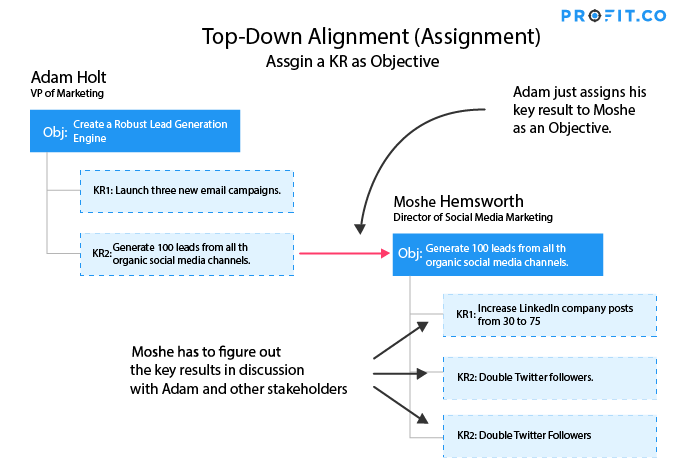Key Results are the targets and outcomes used to measure the success of your quality objectives. Good key results provide indisputable evidence that you and your peers have made progress on a certain initiative.
Quality is more important than quantity. One home run is much better than two doubles.
Writing good, effective key results
To create strong, qualitative key results for your objectives, ask yourself the following questions so you can have the highest-quality key results for your quarter.
A checklist for writing quality key results for OKRs
1. Are the Key Results Aligned?
2. Are the Key Results Measurable?
3. Are the Key Results the same as your team’s day-to-day tasks?
4. Is there Pairing Between Key Results?
5. Are the Key Results Controllable?
6. Is There an Accountability System for Key Results?
1. Are the Key Results Aligned?
When choosing quality objectives, it’s important to always stay aligned and in sync with the company and departmental priorities. This also applies when selecting key results as well. If your key results are not aligned with the objectives — then it will confuse your team members. It will also lower your chances of achieving your objectives.
Let’s use a Marketing Department objective to “Create a Robust Lead Generation Engine”.
From here, the VP of Marketing should discuss with each Marketing Team Leads about setting up the right key results. In turn, each Team Leader creates respective Objectives and Key Results to contribute and align to the Department’s Objective.
- Department Objective: “Create a Robust Lead Generation Engine”.
- Department KR1: Launch three new email campaigns.
- Department KR2: Generate 100 leads from all the organic social media channels.

One of these key results can also be objectives for one of the Teams. For example, the social media team might choose “Generate X leads from all organic social media channels” as one of their objectives. Then they would create respective KRs for this objective.
 Objective
Objective
Generate 100 leads from all the organic social media channels.
Target Date: Annual-2021
Visibility: All Employees
 Key Results
Key Results
Increase LinkedIn company posts from 30 to 75
Increase Twitter followers from 250 to 500
These key results are then assigned to the members of the social media team.
2. Are the Key Results Measurable?
As discussed earlier, key results must be numeric and measurable. They should specify a set goal that you must accomplish to progress the objective. A common mistake made in OKR implementation is picking qualitative key results.
How do you measure OKRs?
Let’s say one of your objectives is “To increase new revenue by 50%”. It’s a clear and straightforward goal. And let’s say you choose vague key results such as:
- KR 1: Increase sales calls.
- KR 2: Change pricing model.
- KR 3: Increase renewals.
Even though the key results are the right action steps, they don’t signal clarity to your team. Your team is not sure how many calls they need to make or what changes to make to the pricing model.
Instead, your key results must be specific and concise, such as:
 Objective
Objective
To increase new revenue by 50%
Target Date: Annual-2021
Visibility: All Employees
 Key Results
Key Results
Increase sales outreach to 50 calls per day per sales rep.
Finalize and launch a pricing model within 30 days.
Aim for an 80% renewal rate for existing clients.
These examples of key results can help Sales Managers and the Sales & Renewal teams to focus on the right activities to help reach them.
3. Are the Key Results the same as your team’s day-to-day tasks?
Occasionally, Key Results are confused with daily tasks. As the name denotes, “Key Results” are specific results that you need to attain — while “Tasks” are day-to-day things that your team engages in.
Let’s take the example of a social media team in the Marketing Department. The following are some of their daily or weekly tasks:
- Create and update content schedules.
- Create images for social media sharing.
- Get training on the updated version of Hootsuite.
- Analyze metrics weekly.
The above tasks are what they need to do to ensure that they stay on top of their projects. The completion of these tasks might even be tied to their performance reviews. Key results have to be numeric and have to stretch your team beyond their daily and normal capabilities. Here are examples of good Key Results for a social media team to Improve online reach:
 Objective
Objective
Improve online reach
Target Date: Annual-2021
Visibility: All Employees
 Key Results
Key Results
Increase Instagram followers from 725 to 1450
Maintain LinkedIn Post 3 times a week.
Increase new leads from paid campaigns on Facebook and Instagram from 0 to 50
4. Is there Pairing Between Key Results?
We’ve consistently mentioned that Key Results need to be quantifiable to be effective. However, a common mistake made by teams implementing OKRs is that they set too many quantifiable key results. In their haste to achieve more in that period, teams make the mistake of ignoring the quality of the key results.
Pairing both quantity and quality of key results is crucial. Otherwise, you’ll end up hitting all your metrics at the expense of quality and customer satisfaction.
Let’s take an example of an OKR set by a company related to increasing annual revenues.
 Objective
Objective
Increase ARR by 50% in the Fiscal year 2021
Target Date: Annual-2021
Visibility: All Employees
 Key Results
Key Results
Acquire 5 new referrals
Increase Marketing Spend by 50% to attract more customers
Hire 5 new salespeople
At the outset, this OKR seems like it meets the characteristics of a strong, quality OKR. However, the KRs in this example is only focused on new channels or revenue-generating activities. It completely misses the opportunity within existing customers. It also doesn’t take into account any potential churn or revenue loss.
If you are only adding new customers/revenues at the top but fail to fill the “leaky bucket” wherein you are losing customers daily — you are hampering your growth and profitability.
With that in mind, here’s a revised OKR with the proper pairing between Key Results will look like:
 Objective
Objective
Increase ARR by 50% in the Fiscal year 2021
Target Date: Annual-2021
Visibility: All Employees
 Key Results
Key Results
Acquire 5 new referrals
Increase Marketing Spend by 50% to attract more customers
Hire 5 new salespeople
Reduce churn rate from 30% to 5%
Introduce customer retention and renewal program
KR4 and KR5 ensure that you are also taking care of existing customers and reducing your churn. By properly pairing all the key results — you are ensuring that you are taking a holistic approach towards attaining that objective.
The same principle applies to other areas of business, such as:
- Customer Service: It’s great to add new features, but you must also ensure that there are fewer bugs overall.
- Website: You can aim for higher website traffic, but if your bounce rate is high, then you are not converting enough.
- Content Marketing: It’s not a bad idea to publish more content, but if your content is not high-quality and converting — then your content marketing program is not profitable.
5. Are the Key Results Controllable?
Another quality criterion to keep in mind when choosing Key Results is that they must be controllable. In other words, you should have the ability to influence the outcome of the Key Results.
Hence, we suggest key results that your team members can act on and measure. If you choose key results that you cannot influence or those that depend on external factors — they may or will not align with the objective.
For example, let’s say one of your Marketing Team Objectives is to “Increase search engine traffic by 100%”. You should refrain from using KRs that rely on external factors, such as:
- KR 1: Avoid being flagged by Google algorithms
- KR 2: Have other sites automatically link to us
Both these examples denote things that you cannot control. Your KRs must target things that you can influence internally. Here are some examples of good Key Results for the same Objective:
 Objective
Objective
Increase search engine traffic by 100%
Target Date: Annual-2021
Visibility: All Employees
 Key Results
Key Results
Publish atleast 3 blog posts per week
Complete on-page SEO project
Hire an external link-building team to start gaining links
You can assign the above key results to your teams and team members. They can then easily track and measure the performance of these KRs and report on their progress.
6. Is There an Accountability System for Key Results?
Another essential element of success with the OKR methodology is “Tracking“. If you are not adequately tracking and measuring your progress — then you will not know whether you are moving in the right direction.
![]()
Measurements are not new for companies. Whether you are a startup or a large organization — you already have some system in place to report on your KPIs:
- Sales:CRM.
- Marketing: Marketing Automation Platforms, Analytics tools.
- Customer Service:Ticketing systems.
- Engineering Teams: Software bug tracking system
- Finance: Profit-and-loss Statements, Balance Sheet.
As Peter Drucker famously said, “What gets measured, gets managed”. We also believe that what gets measured gets tracked gets improved.
Most of the example key results we have discussed so far are easily trackable in your CRM, marketing platforms, or project management tools.
However, the additional element of periodic check-ins (weekly) allows everyone to know where they stand and how far the team is in their quest to reach the objective.
We recommend weekly check-ins to ensure that everyone is on the same page. You can do this by updating everyone at your regular team meetings or even Company Town Halls (for Corporate Objectives). You can also use an OKR software or tool to provide visibility to all stakeholders.
Periodic check-ins and accountability also help you make the necessary course corrections if you are far off from your goal or heading in the wrong direction.
By ensuring that your key results are high-quality, you set yourself and your team up for success in the coming quarter and can measure the progress of your objective with clarity and focus. Creating quality OKRs is the first step in achieving your ambitious goals and starting off a new quarter strong with focus, alignment, and clarity.

